- Details
- Last Updated on Monday, 10 August 2015 00:50
67/P Churyumov-Gerassimenko Comet
This comet was discovered by the Soviet astronomers Klim Ivanovych Churyumov (Kiev University’s Astronomical Observatory) and Svetlana Ivanovna Gerasimenko (Alma-Ata Astrophysical Institute, the then-capital city of Kazakh Soviet Socialist Republic) on 11-Sep-1969.
 The orbit of Comet 67P/Churyumov–Gerasimenko and its approximate location around perihelion, the closest the comet gets to the Sun. The positions of the planets are correct for 2015-Aug-13, . The comet will pass closest to Earth in February 2016 at 218.2 million km but will be brightest this month right around perihelion. Copyright: ESA.
The orbit of Comet 67P/Churyumov–Gerasimenko and its approximate location around perihelion, the closest the comet gets to the Sun. The positions of the planets are correct for 2015-Aug-13, . The comet will pass closest to Earth in February 2016 at 218.2 million km but will be brightest this month right around perihelion. Copyright: ESA.
In fewer than two weeks, the comet will reach perihelion, its closest approach to the Sun at 186 million km, and the time when it will be most active. Rosetta will continue to monitor 67P C-G from a safe distance to lessen the chance an errant chunk of comet ice or dust might damage its instruments. Activity will gradually decline after perihelion with Rosetta providing a ringside seat throughout. The best time for viewing the comet from Earth will be mid-month when the Moon is out of the morning sky. Watch for an article with maps and directions soon.
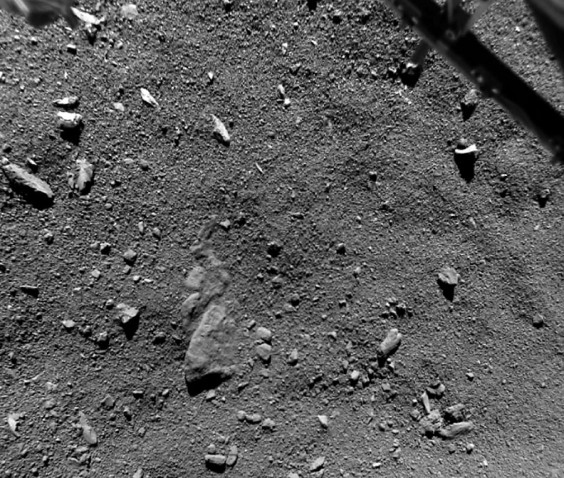 We’ve never seen a comet as close as this. Taken shortly before touchdown by the Philae lander on2014-Nov-12, you’re looking across a scene just 9.7-meters from side to side - about the size of a living room. Part of the lander is visible at upper right.
We’ve never seen a comet as close as this. Taken shortly before touchdown by the Philae lander on2014-Nov-12, you’re looking across a scene just 9.7-meters from side to side - about the size of a living room. Part of the lander is visible at upper right.
Credit: ESA/Rosetta/Philae/ROLIS/DLR.
With just 12 days before Comet 67P/Churyumov-Gerasimenko reaches perihelion, we get a look at recent images and results released by the European Space Agency from the Philae lander along with spectacular 3D photos from Rosetta’s high resolution camera.
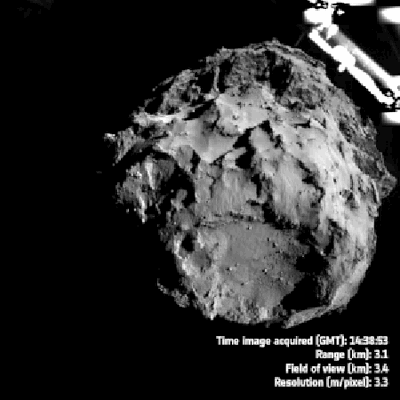 Slow animation of images taken by Philae’s Rosetta Lander Imaging System, ROLIS, trace the lander’s descent to the first landing site, Agilkia, on Comet 67P/Churyumov–Gerasimenko on November 12, 2014.
Slow animation of images taken by Philae’s Rosetta Lander Imaging System, ROLIS, trace the lander’s descent to the first landing site, Agilkia, on Comet 67P/Churyumov–Gerasimenko on November 12, 2014.
Credits: ESA/Rosetta/Philae/ROLIS/DLR.
Remarkably, some 80% of the first science sequence was completed in the 64 hours before Philae fell into hibernation. Although unintentional, the failed landing attempt led to the unexpected bonus of getting data from two collection sites — the planned touchdown at Agilkia and its current precarious location at Abydos.
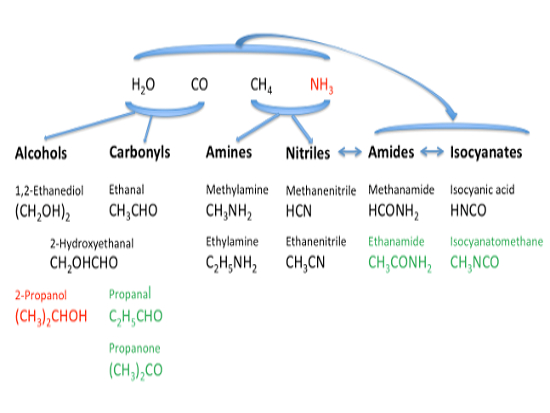 After first touching down, Philae was able to use its gas-sniffing Ptolemy and COSAC instruments to determine the makeup of the comet’s atmosphere and surface materials. COSAC analyzed samples that entered tubes at the bottom of the lander and found ice-poor dust grains that were rich in organic compounds containing carbon and nitrogen. It found 16 in all including methyl isocyanate, acetone, propionaldehyde and acetamide that had never been seen in comets before.
After first touching down, Philae was able to use its gas-sniffing Ptolemy and COSAC instruments to determine the makeup of the comet’s atmosphere and surface materials. COSAC analyzed samples that entered tubes at the bottom of the lander and found ice-poor dust grains that were rich in organic compounds containing carbon and nitrogen. It found 16 in all including methyl isocyanate, acetone, propionaldehyde and acetamide that had never been seen in comets before.
The complexity of some of these organics hints that even in the deep cold and radiation-saturated no man’s land of outer space, a rich assortment of organic materials can evolve. Colliding with Earth during its early history, comets may have delivered chemicals essential for the evolution of life.
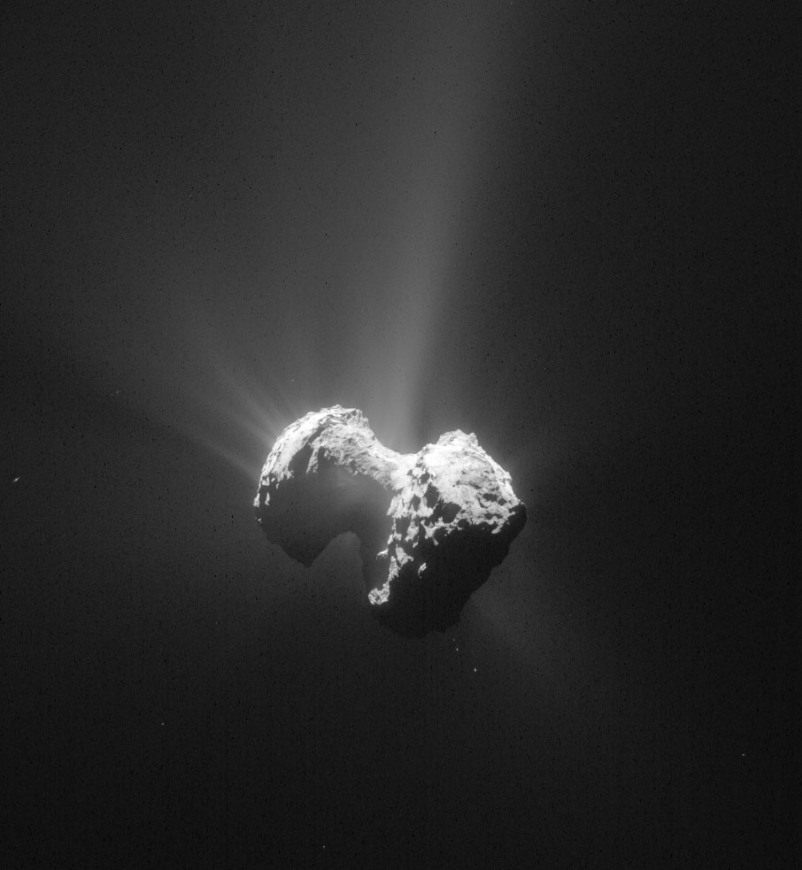 Comet 67P/Churyumov-Gerassimenko on 2015- Jul-20, taken from a distance of 171 km from the comet’s center. Rosetta has been keeping a safe distance recently as 67P/C-G approaches the August 13th perihelion. Credit: ESA/Rosetta/NAVCAM – CC BY-SA IGO 3.0 .
Comet 67P/Churyumov-Gerassimenko on 2015- Jul-20, taken from a distance of 171 km from the comet’s center. Rosetta has been keeping a safe distance recently as 67P/C-G approaches the August 13th perihelion. Credit: ESA/Rosetta/NAVCAM – CC BY-SA IGO 3.0 .
“With perihelion fast approaching, we are busy monitoring the comet’s activity from a safe distance and looking for any changes in the surface features, and we hope that Philae will be able to send us complementary reports from its location on the surface,” said Philae lander manager Stephan Ulamec.
Philae’s MUPUS probe took temperature measurements and hammered into the surface at the landing site to discover a layer of very hard water ice. Credit: ESA
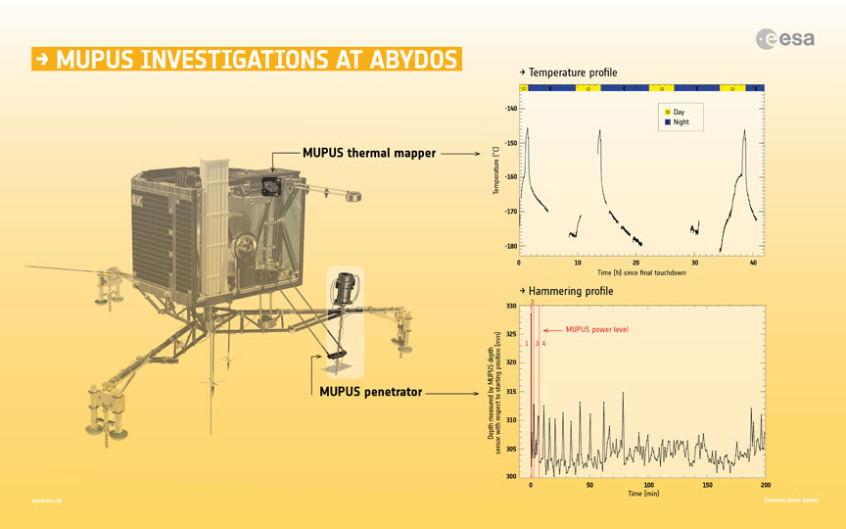 An uncontrolled, chaotic landing. Stuck in the shadow of a cliff without energy-giving sunlight. Philae and team persevered. With just 60 hours of battery power, the lander drilled, hammered and gathered science data on the surface of comet 67P/Churyumov-Gerassimenko before going into hibernation. Here’s what we know.
An uncontrolled, chaotic landing. Stuck in the shadow of a cliff without energy-giving sunlight. Philae and team persevered. With just 60 hours of battery power, the lander drilled, hammered and gathered science data on the surface of comet 67P/Churyumov-Gerassimenko before going into hibernation. Here’s what we know.
Despite appearances, the comet’s hard as ice. The team responsible for the MUPUS (Multi-Purpose Sensors for Surface and Sub-Surface Science) instrument hammered a probe as hard as they could into 67P’s skin but only dug in a few millimeters:
“Although the power of the hammer was gradually increased, we were not able to go deep into the surface,” said Tilman Spohn from the DLR Institute of Planetary Research, who leads the research team. “If we compare the data with laboratory measurements, we think that the probe encountered a hard surface with strength comparable to that of solid ice,” he added. This shouldn’t be surprising, since ice is the main constituent of comets, but much of 67P/C-G appears blanketed in dust, leading some to believe the surface was softer and fluffier than what Philae found.
This finding was confirmed by the SESAMEexperiment (Surface Electrical, Seismic and Acoustic Monitoring Experiment) where the strength of the dust-covered ice directly under the lander was “surprisingly high” according to Klaus Seidensticker from the DLR Institute. Two other SESAME instruments measured low vaporization activity and a great deal of water ice under the lander.
As far as taking the comet’s temperature, the MUPUS thermal mapper worked during the descent and on all three touchdowns. At the final site, MUPUS recorded a temperature of –243°F (–153°C) near the floor of the lander’s balcony before the instrument was deployed. The sensors cooled by a further 10°C over a period of about a half hour:
“We think this is either due to radiative transfer of heat to the cold nearby wall seen in the CIVA images or because the probe had been pushed into a cold dust pile,” says Jörg Knollenberg, instrument scientist for MUPUS at DLR. After looking at both the temperature and hammer probe data, the Philae team’s preliminary take is that the upper layers of the comet’s surface are covered in dust 4-8 inches (10-20 cm), overlaying firm ice or ice and dust mixtures.
The ROLIS camera (ROsetta Lander Imaging System) took detailed photos during the first descent to the Agilkia landing site. Later, when Philae made its final touchdown, ROLIS snapped images of the surface at close range. These photos, which have yet to be published, were taken from a different point of view than the set of panorama photos already received from the CIVA camera system.
During Philae’s active time, Rosetta used the CONSERT (COmet Nucleus Sounding Experiment by Radio wave Transmission) instrument to beam a radio signal to the lander while they were on opposite sides of the comet’s nucleus. Philae then transmitted a second signalthrough the cometback to Rosetta. This was to be repeated 7,500 times for each orbit of Rosetta to build up a 3D image of 67P/C-G’s interior, an otherworldly “CAT scan” as it were. These measurements were being made even as Philae lapsed into hibernation. Deeper down the ice becomes more porous as revealed by measurements made by the orbiter.
The last of the 10 instruments on board the Philae lander to be activated was the SD2 (Sampling, Drilling and Distribution subsystem), designed to provide soil samples for theCOSACandPTOLEMYinstruments. Scientists are certain the drill was activated and that all the steps to move a sample to the appropriate oven for baking were performed, but the data right now show no actual delivery according to a tweet this morning from Eric Hand, reporter atScience Magazine. COSAC worked as planned however and was able to “sniff” the comet’s rarified atmosphere to detect the first organic molecules. Research is underway to determine if the compounds are simple ones like methanol and ammonia or more complex ones like the amino acids.
Stephan Ulamec, Philae Lander manager, is confident that we’ll resume contact with Philae next spring when the Sun’s angle in the comet’s sky will have shifted to better illuminate the lander’s solar panels. The team managed to rotate the lander during the night of November 14-15, so that the largest solar panel is now aligned towards the Sun. One advantage of the shady site is that Philae isn’t as likely to overheat as 67P approaches the Sun en route to perihelion next year. Still, temperatures on the surface have to warm up before the battery can be recharged, and that won’t happen until next summer.
Let’s hang in there. This phoenix may rise from the cold dust again.
My Comments:
- The heavy hydrogen (deuterium) to the light one ratio was determined as about 3x higher than on the Earth. This should disproof the theory that the Earth's water came from comets falling onto our planet in its early stage. I assume that the high deuterium content on comets such as Chury only indicates their multiple approach to Sun, where they were subject to repeated strong sublimations (as known from their tails). Moreover I assume that there may exist comets with pristine history, wihout too many approaches the Sun and therefore with a lower deuterium content, closer to that of the Earth.
- Initial great jumping of the Rosetta' lander Philae onto a soft regolith ground contrasted with a relatively limited final jumping on a hard ground. The reason was the different lander's speed: the initial high lander's speed has been not enough absorbed by the lander's shock absorbers, whereas the later rebound happened under relatively slow lander's speed and was therefore limited. The rebound is proportional to the impact speed, a dependence on a rebound elastic properties is much smaller, especially because we do not know them.

